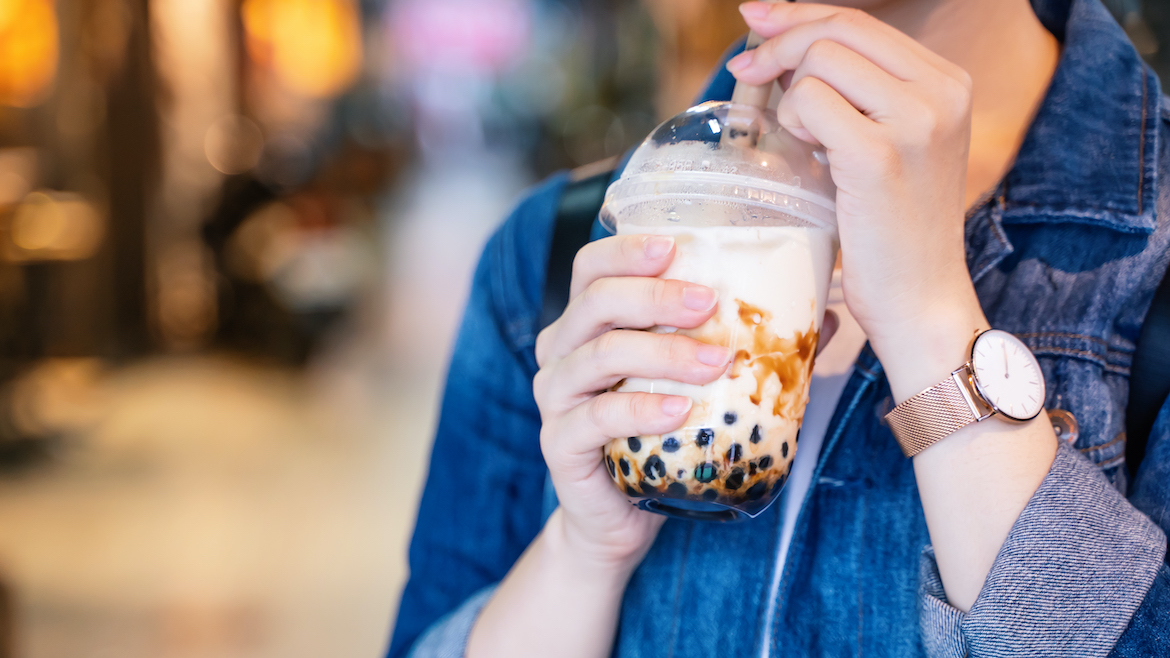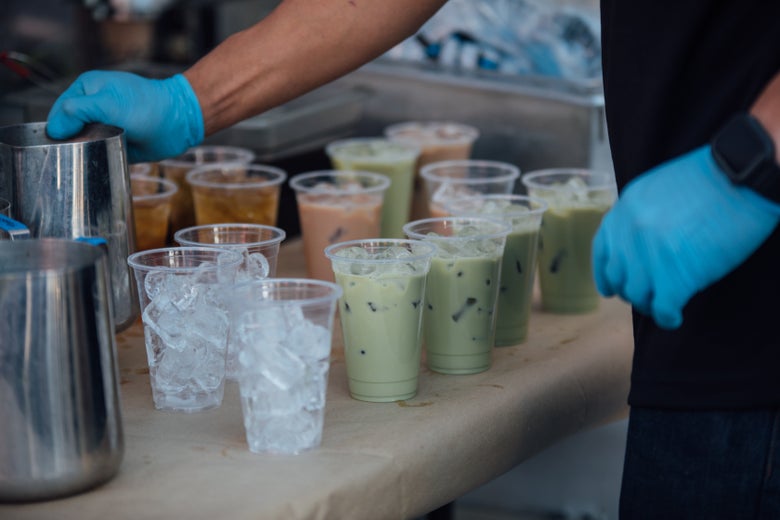What Is Bubble Tea and What Are Its Benefits, per an RD
 ]
]
E ven if you’ve never actually tried boba tea—also known as bubble tea—there is a good chance you’re familiar with what it is. The delicious milky tea drink made with tapioca pearls has grown in popularity in the U.S. since the ’90s and ven if you’ve never actually tried boba tea—also known as bubble tea—there is a good chance you’re familiar with what it is. The delicious milky tea drink made with tapioca pearls has grown in popularity in the U.S. since the ’90s and has a global worth of $2 billion
To the delight of many, boba tea shops are popping up all across the U.S., and are especially popular in cities like Los Angeles and Miami. (If you’ve stood in a line so long it snaked around the block for your boba fix, you know exactly what we’re talking about.) Another indicator of just how beloved boba tea has become in the U.S.? The fact that this month, food giant Del Monte is releasing the first shelf-stable boba tea, Joyba. While this means the tea will soon be available at a grocery store near you, before you stock up, it’s important to know the origins of the drink as this is a beverage with a rich history. You want to be able to enjoy the delish drink while honoring its roots, right?
Consider this your guide to boba tea. Get ready to be schooled on the history of the drink, nutritional facts, how it’s made, and tips for enjoying it.
What is bubble tea, and what health benefits does it offer?
Boba tea’s roots can be traced back to Taiwan in the early 1980s—pretty recent when you consider that most types of teas have been sipped for centuries. Tea with milk was already a common drink in Taiwan. In the ’80s, two tea shops came up with the idea (independently of each other) to add little tapioca pearls to it. As you can guess, people went wild for the result, and it’s popularity grew quickly across Asia—and in the decades following, across the globe.
Related Stories
Nutrition expert Asako Miyashita, RD, says she remembers first having boba tea in the ’90s, as a teenager living in Japan. She explains that boba tea can be made with different types of tea, most commonly black tea, green tea, or white tea. Besides the tea, the other ingredients are milk, ice, and of course, the chewy tapioca pearls.
Miyashita says when bubble tea is made with these simple ingredients, it is full of nutritional benefits. She explains that black, green, and white tea are all high in antioxidants, which are linked to supporting brain health. Antioxidants reduce inflammation, which helps protect against certain cancers and diseases and is also linked to longevity. Antioxidants protect the brain by reducing oxidative stress, which is detrimental to brain function.
Miyashita says all the tea options have nutritional benefits, so boba tea drinkers should feel free to go with whatever they like the taste of. That being said, she does highlight some specific benefits of choosing green tea. “Green tea contains a catechin called EGCG,” she says. This specific type of catechin has been shown to inhibit tumor growth. White tea has also been shown to protect against neurodegenerative diseases (at least in rats) and both teas have been linked to supporting the immune system. More of a black tea drinker? Black tea is especially good for the gut while also protecting against inflammation and supporting the immune system. Basically, you can’t go wrong.
Curious about those tapioca pearls? Miyashita says while they certainly aren’t unhealthy, their nutritional benefits are minimal. “Tapioca derives from cassava tubers and consists of starchy carbohydrates but fewer fibers. Cassava itself contains nutrients such as vitamin C and calcium, iron—but little,” she says. “When cassava is cooked [as they are when making boba tea], most nutrients are destroyed. That’s why tapioca pearls have fewer health benefits.” So while the pearls are part of the essence of boba tea, they aren’t exactly nutrient rich.
Milk is also a crucial part of boba tea—and if you go with standard cow’s milk, you’re getting good amounts of calcium, protein, vitamin D, and vitamin A. As more people are turning to plant-based milks, options like oat and almond have become available at more bubble tea shops. While alternative milks do have some nutritional benefits, they’re primarily made of water, so the benefits are minimal.
Watch the video below to find out which alternative milk is the healthiest, according to a registered dietitian:
Sometimes boba tea is made with condensed milk, an add-in Miyashita isn’t in favor of nutritionally. “Condensed milk typically contains sugar,” she says. For this reason, she says it’s best to add just a splash to your boba tea, if you choose to add it at all.
How to enjoy boba tea while honoring its roots
Even though boba tea has been around for decades, there hasn’t been a shelf-stable way to enjoy it until this month. Locca Boba Tea founder Emre Yenici says there are a couple of reasons why boba tea is hard to bring to the masses in this way. One reason, he says, is because of the milk; cow’s milk must be kept cold and has a relatively short window of when it must be consumed. “This is why you’ll notice that boba tea is more commonly sold in kits with powder milk for people to make at home,” he says.
Yenici says the other reason is because tapioca pearls take time to cook. “Some brands try to get around this by using instant tapioca pearls which are easier to use, but in my opinion are not as authentic as using the tapioca pearls that require cooking,” he says. Yenici—whose brand sells a variety of boba tea kits—says ingredient sourcing is really important to him as he wants people to make and enjoy boba tea at home as authentically as possible. “We source most of our teas from Taiwan,” he says, adding that the others they use are from other Asian countries.
Del Monte Foods vice president Mario DiFalco says creating a boba tea that honored its Taiwanese roots was of utmost importance to the brand. “We partnered with a Taiwanese supplier for the boba tea ingredients and also put a lot of thought into how the drink would be packaged,” he says. For example, this is one drink they definitely weren’t going to use a can for. Instead, they use cups that come with straws big enough for the pearls to fit through.
DiFalco says it certainly wasn’t easy to figure out how to create a shelf-stable boba tea. As Yenici highlighted, the obstacles are very real. Figuring out the cups themselves, he says, was one hurdle. DiFalco says it was important to the food company that the cups be just like what you’d get at a bubble tea shop, but the straws had to be included in a way where they wouldn’t get unattached to the cup during the shipping process.
Then, of course, was the work of creating boba tea flavors that were authentic and delicious. While the brand’s commitment is honorable, there are some differences between Joyba and traditional boba tea worth noting. The boba bubbles are made from water, sugar, calcium lactate, citric acid, corn starch, and a few other ingredients—an ingredients list similar to the instant tapioca pearls Yenici says some brands turn to in place of tapioca pearls that have to be cooked. It’s also made with brewed tea and calcium lactate, not milk. These changes allow the beverage to not spoil as easily. Ultimately, DiFalco says, he hopes Joyba is a way for people who are already familiar with boba to enjoy it on-the-go while also introducing people who’ve never tried it to the drink.
Yenici reiterates that if you want to enjoy boba tea while honoring its cultural roots, find out where the ingredients are being sourced from; truly authentic boba tea is from Taiwan. This advice is key for whether you’re popping into a local boba tea shop, using a kit to make it at home, or buying it at the grocery store. With that in mind, the fact that boba tea is becoming easier to find is definitely a positive. I mean, how many drinks come accessorized with pearls?
Oh hi! You look like someone who loves free workouts, discounts for cult-fave wellness brands, and exclusive Well+Good content. Sign up for Well+, our online community of wellness insiders, and unlock your rewards instantly.
Enter Email Address
A Bubble Tea–Making Robot Is a Portent of Things to Come
 ]
]
In the airy lobby of Taipei’s new technology hub, customers are waiting on their boba fix at Crane Cha, a beverage store. Behind a plexiglass partition, a robot is assembling their drinks.
The Bubble Tea Shaker Robot, or BTSR, launched in 2018 and is the brainchild of Taiwan Intelligent Robotics Co. After the machine receives a customer’s order, its thick white robotic arm moves along a wall of nozzles to fill up on ingredients—tea, milk, ice, sugar, toppings—in its stainless steel shaker. The BTSR shakes it to mix and pours the contents into a paper cup, which is sealed and handed to the customer. Over and over, exactly the same every time.
Advertisement
In Taiwan, there are more than 20,000 drinks stores that do it the old-fashioned way. Young part-time workers assemble a drink in a series of standardized steps; at some stores they might rely on a motorized shaker, but the operation is primarily manual and susceptible to human inconsistencies. With more than 100 million drinks sold a year, some companies are betting on these beverages—more commonly called hand-shaken drinks in Taiwan—to be made by robotic hands instead.
Advertisement
Advertisement
A boba robot is a particularly Taiwanese instance of the global trend of automation in the restaurant industry. According to Research Nester, the cooking robotics market will be worth $322 million by 2028. That’s more than 70 percent growth projected in nine years. In an industry that’s typically low-margin and heavily dependent on human labor, automated technology promises to make operations cheaper and more effective.
Advertisement
Cafés are an obvious site for disruption—ubiquitous and dependent on baristas. San Francisco’s VC-backed Cafe X is an automated café system also featuring a robotic arm; other robo-baristas from smaller upstarts include Belarus’s Rozum Robotics and Colorado’s Robo Esso. There are also companies taking on the harder task of assembling full meals. Boston’s Spyce is a conveyor belt kitchen making salads and warm bowls. Bangalore’s Mukunda Foods makes automated cooking equipment for restaurants to make local dishes like biryani.
In Taiwan, boba is the quintessential national drink, and one of the country’s main cultural exports.
BTSR isn’t even the first boba robot, nor is Cran Cha the first shop to adopt such technology. In recent years, other upstarts have opened and shuttered. Babo Arms, which self-proclaimed as the world’s first robot beverage store, opened in Taipei’s popular Dongmen District in 2018 before closing one year later. Jhu Dong Auto Tea, a beverage store in Taichung’s popular Fengjia Night Market, opened in 2019 and quickly suffered a similar fate.
Advertisement
Advertisement
The fact that numerous stores have experimented with automation—despite failing—is a clear response to growing international and local pressures. Taiwan’s beverage retail market is competitive, robot or no robot. According to a survey from the Ministry of Economic Affairs, the biggest challenges facing beverage store owners are high staff turnover, intense competition, and rising operating costs. The number of stores has almost doubled in the past decade and the market is beginning to saturate. Businesses are looking for other ways to grow and overseas expansion is one attractive option, with Taiwanese beverage stores now in business on five continents. But even abroad, difficulties persist.
“The biggest challenge that Taiwanese beverage companies face overseas is standardizing the Standard Operating Procedure and training,” said K.T. Huang, the CEO of Taiwan Intelligent Robotics Co. Most inquiries he has received for the BTSR have come internationally, and the robot is an attempt to solve those problems.
Advertisement
It’s expensive to set up overseas operations, according to Huang, for it takes 20 to 30 managers about one to three months of training. Ongoing operations costs are also high, especially overseas where wages are higher than in Taiwan. But a store outfitted with the BTSR needs just one worker, rather than the average four to six, to help with stocking and customer delivery. By Huang’s calculations, if stores with BTSR are centralized in an urban area, 30 to 40 percent of the corporate costs in training and regional management can be cut. An investment in the BTSR doesn’t take long to break even: a year in the U.S., and two to three years in Taiwan. The pandemic interrupted many of Taiwan Intelligent Robotics Co.’s overseas conversations, but also underscored the need for automated solutions.
Advertisement
Advertisement
Like Taiwan Intelligent Robotics Co., NOOONE, a company designing robotics solutions for beverages and pastries, says that most of its inquiries are coming from overseas, especially from Taiwanese business people in the U.S. Those in countries with higher wages are showing the most interest. For the trend to take off in Taiwan, CEO Chang Shu-hao said, the cost of the equipment has to come down from today’s industry starting price of roughly $20,000. More collaboration and resources in the industry in the next few years could make that a reality.
Back in Taiwan, however, interest and demand have been minimal. The average beverage store doesn’t survive longer than three to five years. The cost of labor isn’t prohibitively high enough—due to stagnating wages in the last two decades—to compel the small businesses to adopt an automated solution yet.
Advertisement
Experiments in automation in the restaurant and beverage industry in Taiwan have been precisely that—experiments. The giants are nowhere to be seen yet. Qingxin Fuquan, the biggest beverage franchise in Taiwan with more than 900 stores, said that it has“no plans at the moment” for automation. Kebuke, a hipper upstart that is popular among younger customers, responded likewise.
Advertisement
Other experiments from larger corporations in Taiwan have yet to lead to widespread adoption. Convenience stores that depend on part-time workers doing manual work are an example. 7-Eleven piloted an unstaffed convenience store in 2018, to initial excitement but lackluster demand, and it closed in a year. In the same year, Fujitsu partnered with FamilyMart to pilot the RoboPin, a desktop-sized robot, to interact with customers and show off new products. Others are exploring smart vending machines and coffee makers.
Advertisement
Outside of Taiwan, there are promising signs of larger-scale implementation. After White Castle’s successful pilot in 2020 of Flippy the robot burger flipper, the plan is to roll it out to 10 new stores. The goal is for Flippy to improve customer service and kitchen operations—and to increase safety during a global pandemic.
Consumers need time to adapt to and adopt automation. NOOONE’s Chang opened an unstaffed concept store in Taichung, Taiwan, to see how customers responded. He said they liked that the store was clean and sanitary, and found it novel and interesting. But visitors from central and southern Taiwan—and especially those above the age of 40—had trouble using the digital interface to order. While these interfaces are prevalent in Taipei, they have yet to penetrate widely to the rest of the country.
Advertisement
Advertisement
Advertisement
Automation may reduce, but not fully eliminate, the need for human staff. While the BTSR can run entirely solo in Huang’s design—save for when ingredients need stocking—having one person on staff adds a human element. “Service needs warmth,” Huang said, and staff can assist with ordering and hand-delivering the beverage from the service window to the customer.
“Automation will inevitably become a trend,” Chang said. He predicts prices will be competitive in Taiwan in the next five years, and the technology will be more prevalent in 10. “It needs some time to ferment.”
Soon, it won’t be a novelty to sip on your robo-made boba while eating a robo-flipped burger or convey-belt assembled salad—or maybe even a beef noodle soup.
Future Tense is a partnership of Slate, New America, and Arizona State University that examines emerging technologies, public policy, and society.
Culture ministry backs Taiwan TV host boycotted for Olympic remarks
 ]
]